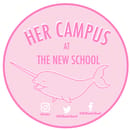On your next trip to the mall, swing by the Victoria’s Secret store and stand inside for a minute. Observe the lighting, the blown-up pictures of gorgeous air-brushed models, and the consumers. Around you, you will see that you are in a sea of women, all ranging from the ages of 13 to 80. It’s probably safe to say there is not any person who identifies as a woman and has not visited Victoria’s Secret store at some point after their transition into “womenhood.” But what makes their bras so appealing? Why are we willing to spend 50 dollars on a piece of fabric made to restrict an over-sexualized body part (we have been fostered to think that our milk producing, sacks of fat are meant to stay restrained in an uncomfortable garment that leaves red lines on our bodies at the end of the day from companies like Victoria’s Secret). Through its use of religious ideographs and language, the VS Angels represent how companies have used spiritual capitalism to define their brand.
VS bras are not comfortable or unique, nor do they alter our appearance, but we continue to buy them. Consumers’ favorite anecdote about VS is that it was made and started by a man, nobody ever discredits or questions this. We completely absorb the fact that we are buying a product for women that was sold and created by a man. It’s like we are comfortable with the fact that a team of Don Drapers are selling us the equipment they told us to buy in the first place, thus creating the first fallacy behind the illusion of the brand. However, what separates Victoria’s Secret from competing brands is not the quality of the product, but of the illusion it sells; The Angels. Encapsulating the methodology of spiritual capitalism (a theory and criticism of the mechanics and techniques companies have utilized to cleanse their brand and capitalize off of the moral purity of religious value), the show sells the idea of sex and heaven.
(Photo by Taylor Hill/Getty Images)
Despite recent criticisms, the VS brand has been able to sell off of their methods of spiritual capitalism, appealing to the ideas behind Western religions. The ability to take a celestial being and place them in a sexual gaze has combined two of the longest social trends (sex and religion) and the facade of sex and eternal happiness has been sold in one show.
The Angels are a group of models who have earned the privilege of having their images plastered around the VS stores. The Angels, alongside the other models, have been broadcasted in the Victoria’s Secret Fashion Show for over 20 years. Every year, a different location, and a different theme.
As explained in Brenna Opelka’s Insider article, the Angels are given their status after a long-term contract and devotion to the brand. One cannot simply become an angel, they must sign certain contractual obligations and sign on with the company. The Angels; fate is in the hands of casting director, Ed Razek, the casting director for the show. The Angels are set apart from other models, making them more desirable and more sacred to the viewer. This concept mirrors the rankings in many biblical stories, and the appointing of the “special” or “chosen” one. Much like the biblical accounts of Angels, that were created through Jesus and exist within a hierarchy, the Victoria’s Secrets’ Angels work in the same fashion. Biblical Angels are set as examples for us, they act as God’s servants, and they are faithfully committed to their brand, much like the VS Angels are to their leader, Razek. Granted, the VS marketing brand still offers their lens through a heteronormative gaze, but what they have succeeded in is sexualizing a sacred figure. The Angel is untouched, she is unique, she is special, and she has worked to receive her title.
In the 2011 Victoria’s Secret Fashion Show, the fashion show theme followed heavenly and celestial bodies in fashion. The company, receiving a large cult following, which increased with the first fashion show in 1995, offers a one-hour length feature of 20 something models deemed as “angels” and a variety of top-tier performers. It is the epitome of sex, luxury, class, and lust. The show was separated into 6 segments: Ballet, Super Angels, A Performance, Passion, Aquatic Angels, I Put a Spell On You, and Club Pink. To those who are attracted to women, their heaven is sold as an expensive show with over 20 half-naked models and a sea of some of the most famous artists. For the female, her heaven is sold as the ability to attract any man, to have all eyes on her, and to wear some of the most expensive lingerie.
The first segment of the 2011 show, “Ballet”, broadcasted 11 of their models (6 of them being Angels), in crystal embedded lingerie and wings. Immediately following this is the “Super Angel” segment. Each model in these segments has large flowing hair, soft makeup, skinny waists, and towers over most of the audience. They have wings and long trains behind them. Soft colors are used in the first two segments, showing the paradox between the innocence of their models and their sexual appeal. Almost every single model has wings that weigh from anywhere 20 to 60 pounds, yet they walk with ease and grace, almost as if they are floating above the shiny runway.
What is interesting to note is how the models walk and behave. In between the show, the audience receives exclusive behind-the-scenes videos and interviews, portraying the sisterhood and closeness of the models. The models state that they are extremely grateful to be in this environment, fostering a sense of community. The models mention that they feel comfortable and supported by their company. This mirrors “recruiters” for the church and accounts of people who advocate the purity and their personal experience of how their lives have changed after joining the religion.
Despite being on the same level as neighboring high fashion companies, the angels are different in their runway behavior. They are encouraged to smile, wink, or dance down the runway. They often interact with other Angels or the key performer, showing that they are inviting and warm to the viewers, much like the recruiters who invite wanderers into their religion. Each Angel has a signature walk and look, often ending with looking directly into the camera, inviting the viewer to walk with them and be fully engaged. The Angels(presenting themselves as equals) are kind, warm, and friendly while still selling the product and the idea of sex. The viewers’ gaze is placed on them, expecting to follow them, as if we could reach into the screen, grab their hand, and enter their spheres (sound familiar to the idea of walking into Heaven with your guardian angel?)
What sets aside the 2011 show from the others is the performance by Kanye West and Jay Z. Two prominent rappers, walking down a glittery runway, singing “N***** in Paris” seems out of place and almost as an aberration to the set of beautiful women. What is interesting to note is the engagement the performers have with the audience. Towards of the end of their set, both Kanye and Jay Z, raise their hands in a triangle formation and the entire audience follows along. The camera pans to the crowd, which is rarely seen in the show and broadcasts a sea of people waving their arms in a uniform fashion. I’m not claiming that Jay Z and Kanye West are the Christ-figures of the Victoria’s Secret Fashion Show, but their ability to allure the audience and make them participate in an activity reveals another parallel between religious values and traditions of many religions (that is, if your religion is a capitalist gain and your leaders are two of the biggest, modern-day rappers). What is different between a crowd of people mimicking and praising their favorite performers versus people bowing their heads in prayer? Well, given there are many differences, if Kanye West had said “please bow your heads with me” instead of raising his arms in a triangle like formation, I’m pretty positive people would still follow.
(2011: Kanye West and Jay-Z. Jamie McCarthy/Getty Images Entertainment/Getty Images)
The company has been able to rely on a large portion of their sales of the portrayal of heavenly ideals. The marketing team has encompassed on the idealized concepts of heaven to sell products to not only women themselves, but to the men who see their vision of heaven. What is interesting to note is the sudden decrease in sales and viewers of the Victoria’s Secret brand through the past few years. As society absorbs a more inclusive and diverse lens, the VS team is often criticized for disregarding models of color and body positivity. The Angels have lost their wings and fallen. The show does not involve many models of color or plus size, disabled, or trans women, and the company has realized the perils of their methodologies. Perhaps the company needs to re-brand their portrayal of heaven, offering a more accepting lens, but if they did this, would they lose the concept of heaven? Would a more body positive and racially diverse cast affect the viewers and previous buyers? Would having models with imperfections and “unconventional beauty standards” ruin the illusion of heaven?
Victoria’s Secret Fashion Show. Directed by Hamish Hamilton. With Adriana Lima, Doutzen Kroes, Miranda Kirr. CBS, 2011


